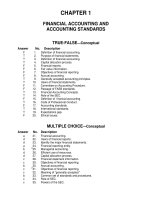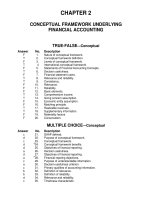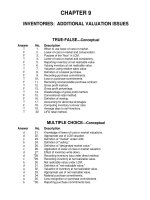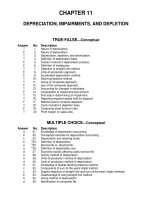Intermediate accounting 16e by kieso slide ch24
Bạn đang xem bản rút gọn của tài liệu. Xem và tải ngay bản đầy đủ của tài liệu tại đây (1.81 MB, 67 trang )
24-1
PREVIEW OF CHAPTER 24
24-2
Intermediate Accounting
16th Edition
Kieso ● Weygandt ● Warfield
24
Full Disclosure in
Financial Reporting
LEARNING OBJECTIVES
After studying this chapter, you should be able to:
1 Review the full disclosure
principle and describe how it is
implemented.
2 Discuss the disclosure
requirements for related-party
transactions, post-balance-sheet
events, major business
segments, and interim reporting.
24-3
3 Identify the major disclosures in
the auditor’s report and
understand management’s
responsibilities for the financial
statements.
4 Identify reporting issues related
to financial forecasts and
fraudulent financial reporting.
LO 1
FULL DISCLOSURE PRINCIPLE
Full disclosure principle calls for financial reporting
of any financial facts significant enough to
influence the judgment of an informed reader.
Financial disasters at Microstrategy, PharMor,
WorldCom, and Lehman highlight the difficulty of
implementing the full disclosure principle.
24-4
LO 1
FULL DISCLOSURE PRINCIPLE
24-5
ILLUSTRATION 24-1
Types of Financial Information
LO 1
FULL DISCLOSURE PRINCIPLE
Increase in Reporting Requirements
Reasons:
24-6
Complexity of business environment.
Necessity for timely information.
Accounting as a control and monitoring device.
LO 1
FULL DISCLOSURE PRINCIPLE
Differential Disclosure
“Big GAAP versus Little GAAP”.
FASB has traditionally taken the position that there
should be one set of GAAP.
FASB is working with an advisory committee to explore
ways that its standards can be more cost-effective for
all companies, regardless of size.
24-7
LO 1
Notes to the Financial Statements
Notes are the means of amplifying or explaining the items
presented in the main body of the statements.
Accounting Policies
Companies should present a statement identifying the
accounting policies adopted and followed.
Should present the disclosure as
► first note or
► separate Summary of Significant Accounting Policies
section preceding the notes to the financial statements.
24-8
LO 1
Notes to the Financial Statements
Which of the following should be disclosed in a Summary of
Significant Accounting Policies?
a. Types of executory contracts.
b. Amount for cumulative effect of change in accounting
principle.
c. Claims of equity holders.
d. Depreciation method followed.
24-9
LO 1
Notes to the Financial Statements
Common Notes
24-10
MAJOR
DISCLOSURES
Inventory
Property, Plant, and Equipment
Creditor Claims
Equityholders’ Claims
Contingencies and Commitments
Fair Values
Deferred Taxes, Pensions, and Leases
Changes in Accounting Principles
LO 1
24
Full Disclosure in
Financial Reporting
LEARNING OBJECTIVES
After studying this chapter, you should be able to:
1 Review the full disclosure
principle and describe how it is
implemented.
2 Discuss the disclosure
requirements for related-party
transactions, post-balancesheet events, major business
segments, and interim
reporting.
24-11
3 Identify the major disclosures in
the auditor’s report and
understand management’s
responsibilities for the financial
statements.
4 Identify reporting issues related
to financial forecasts and
fraudulent financial reporting.
LO 2
DISCLOSURE ISSUES
Disclosure of Special Transactions or Events
24-12
Related Parties
►
Nature of the relationship(s) involved.
►
A description of the transactions for each of the
periods for which income statements are presented.
►
Dollar amounts of transactions for each of the periods
for which income statements are presented.
►
Amounts due from or to related parties.
Errors, fraud, and illegal acts.
LO 2
DISCLOSURE ISSUES
If a business entity entered into certain related party transactions, it
would be required to disclose all the following information except the
a. nature of the relationship between the parties to the
transactions.
b. nature of any future transactions planned between the parties
and the terms involved.
c.
dollar amount of the transactions for each of the periods for
which an income statement is presented.
d. amounts due from or to related parties as of the date of each
statement of financial position presented.
24-13
LO 2
DISCLOSURE ISSUES
Post-Balance Sheet-Events
(Subsequent Events)
1 - Events that provide additional
evidence about conditions that
existed at the balance sheet date.
24-14
ILLUSTRATION 24-3
Time Periods for
Subsequent Events
2 - Events that provide
evidence about conditions that
did not exist at the balance
sheet date.
LO 2
DISCLOSURE ISSUES
Illustration: For each of the following subsequent events, indicate
whether a company should (a) adjust the financial statements, (b)
disclose in notes to the financial statements, or (c) neither adjust nor
disclose.
______
a 1.
Settlement of federal tax case at a cost considerably in
excess of the amount expected at year-end.
24-15
______
c 2.
Introduction of a new product line.
______
b 3.
Loss of assembly plant due to fire.
______
b 4.
Sale of a significant portion of the company’s assets.
______
c 5.
Retirement of the company president.
______
b 6.
Issuance of a significant number of ordinary shares.
(Continued)
LO 2
DISCLOSURE ISSUES
Illustration: For each of the following subsequent events, indicate
whether a company should (a) adjust the financial statements, (b)
disclose in notes to the financial statements, or (c) neither adjust nor
disclose.
______
c 7.
Loss of a significant customer.
c 8.
______
Prolonged employee strike.
______
a 9.
Material loss on a year-end receivable because of a
customer’s bankruptcy.
______
c 10. Hiring of a new president.
______
a 11. Settlement of prior year’s litigation.
______
b 12. Merger with another company of comparable size.
24-16
LO 2
DISCLOSURE ISSUES
Reporting for Diversified Companies
Investors and investment analysts want income statement,
balance sheet, and cash flow information on the individual
segments that compose the total income figure.
24-17
ILLUSTRATION 24-5
Segmented Income
Statement
LO 2
DISCLOSURE ISSUES
Objective of Reporting Segmented Information
To provide information about the different types of business
activities in which an enterprise engages and the different
economic environments in which it operates.
Meeting this objective will help users:
a) Better understand the enterprise’s performance.
b) Better assess its prospects for future net cash flows.
c) Make more informed judgments about the enterprise as a
whole.
24-18
LO 2
DISCLOSURE ISSUES
Basic Principles
GAAP requires that general-purpose financial statements
include selected information on a single basis of segmentation.
A company can meet the segmented reporting objective by
providing financial statements segmented based on how the
company’s operations are managed (management
approach).
24-19
LO 2
DISCLOSURE ISSUES
Identifying Operating Segments
An operating segment is a component of an enterprise:
a. That engages in business activities from which it earns
revenues and incurs expenses.
b. Whose operating results are regularly reviewed by the
company’s chief operating decision-maker.
c. For which discrete financial information is available.
24-20
LO 2
DISCLOSURE ISSUES
Identifying Operating Segments
Quantitative Materiality Test: Must satisfy one to determine
whether the segment is significant enough to warrant actual
disclosure.
24-21
1.
Its revenue is 10 percent or more of the combined revenue of all
the company’s operating segments.
2.
The absolute amount of its profit or loss is 10 percent or more of
the greater, in absolute amount, of (a) the combined operating profit
of all operating segments that did not incur a loss, or (b) the
combined loss of all operating segments that did report a loss.
3.
Its identifiable assets are 10 percent or more of the combined
assets of all operating segments.
LO 2
DISCLOSURE ISSUES
Identifying Operating Segments
Quantitative Materiality Test: In applying these tests, the
company must consider two additional factors.
24-22
1.
Segmented results must equal or exceed 75 percent of the
combined sales to unaffiliated customers for the entire company.
2.
FASB decided that 10 is a reasonable upper limit for the number
of segments that a company must disclose.
LO 2
DISCLOSURE ISSUES
Materiality Test Illustration
24-23
ILLUSTRATION 24-6
Data for Different Possible
Reporting Segments
Reporting segments are therefore A, C, D, and E, assuming that these four
segments have enough sales to meet the 75 percent of combined sales test.
LO 2
DISCLOSURE ISSUES
Materiality Test Illustration
Illustration 24-6
Data for Different Possible
Reporting Segments
The 75 percent test is computed as follows.
75% of combined sales test: 75% x $2,150 = $1,612.50.
The sales of A, C, D, and E total $2,000 ($100 + $700 + $300 + $900);
therefore, the 75 percent test is met.
24-24
LO 2
DISCLOSURE ISSUES
Segmented Information Reported
1. General information about operating segments.
2. Segment profit and loss and related information.
3. Segment assets.
4. Reconciliations.
5. Information about products and services and geographic
areas.
6. Major customers.
24-25
LO 2









